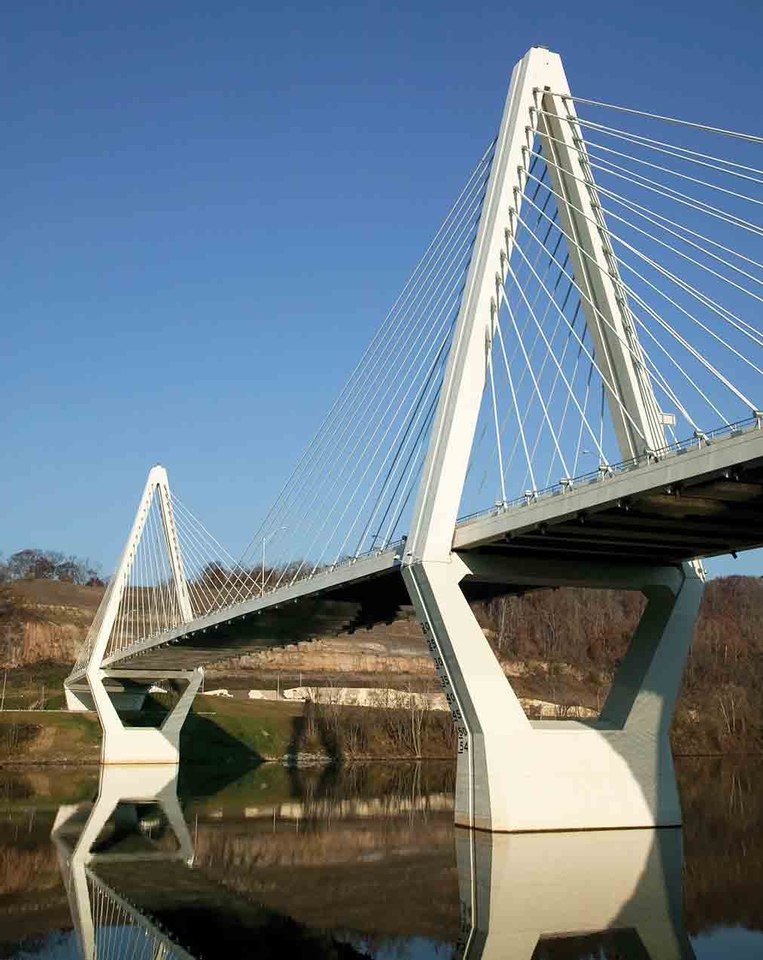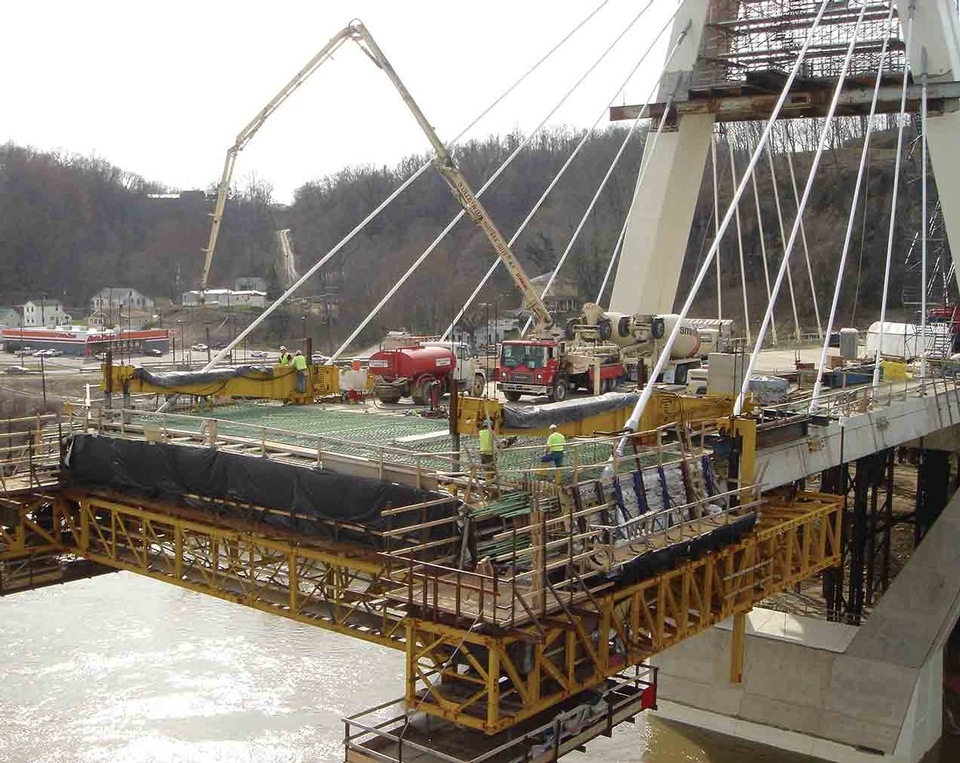Bridge of Honor – Between Pomeroy, Ohio and Mason, West Virginia
The Bridge of Honor, also known as the Pomeroy Mason Bridge, is a concrete cable-stayed bridge with a 675 foot main span crossing the Ohio River. This bridge replaces a functionally and structurally deficient truss bridge connecting the towns of Pomeroy, Ohio with Mason, West Virginia, and provides a vital link between these two communities.
The Bridge of Honor was named to pay tribute to local veterans, specifically the three local Congressional Medal of Honor Recipients listed as honorees for the Bridge of Honor—the late Staff Sgt. Jimmy G. Stewart formerly of Mason, West Virginia, the late Gen. James V. Hartinger, and the late Cpl. Edward A. Bennett, both formerly of Middleport, Ohio. Signage commemorating these honorees was placed on the bridge and unveiled during the dedication ceremony on March 23, 2009.
The cable-stayed superstructure is a cast-in-place segmental concrete edge girder system with transverse floor beams constructed using form travelers. The concrete towers have a delta shape with two planes of cables supporting both edge girders of the superstructure. Each of the towers is supported on six 8-foot-diameter drilled shafts with a waterline footing.
Innovation of Design and/or Construction
The owner of the Bridge of Honor had a keen interest in minimizing future maintenance demands, which drove the decision to develop this design as an all-concrete segmental bridge. The concrete bridge structure minimized needs for future maintenance by several means: the all concrete structure does not require painting; the concrete mix was specified with controls on permeability and concrete quality to enhance corrosion protection; the prestressed structure will minimize cracking and further inhibit future corrosion potential; and the design used only simple neoprene bearings that avoid more complex and maintenance intensive bearing devices. A segmental concrete bridge clearly was the bridge of choice to meet the owner’s needs for this project.
A major challenge and opportunity for innovation for this project was the horizontal alignment curvature of the roadway near the Ohio bank due to the steep rocky hillside that parallels the Ohio shoreline. This horizontal curve forced a short 244-foot end span length for the cable-stayed bridge relative to the 675-foot main-span length to limit the amount of curvature on the bridge. This relatively short end span would normally result in an uplift condition at the anchor piers and the requirement for bearings or devices to resist the uplift. However, the owner tasked the designer to develop a design that avoided uplift devices since these elements typically introduce significant maintenance requirements. The solution was counterweighted end spans that include sufficient ballast concrete to balance the cable-stayed system and eliminate all uplift conditions at the rest pier bearings, eliminating the need for uplift restrainers.
Another innovation on the project was related to providing an economical foundation design that could accommodate the 37-foot range of river levels during flood stages. Water level footings are typically overtopped at some stage of the river flood, creating a navigation hazard due to the shallow water over the submerged footing. The tower foundations and lower legs have a unique geometric configuration that is shaped to be “snag-free” to river traffic under the full range of river stages. This is accomplished by providing a near vertical 1:3 slope of the footing element to create a “snag-free” waterline footing, which eliminated the need for cofferdams and saved both time and money while reducing construction risk.
Aesthetics and/or Harmony with the Environment
The choice of bridge type for this project included a series of public meetings that encouraged local communities to comment on potential bridge types for this site. The overwhelming preference by the public was for a state-of-the-art two-tower, three-span concrete cable-stayed bridge with a delta shaped tower. In addition to being one of the lowest cost options, this bridge type provided a design that gave the local townspeople a feeling of ownership and it brought a sense of pride in the betterment of their communities.
The crossing included a pedestrian pathway on the bridge, including a stainless steel handrail, to enhance opportunities for local access between the cross river communities.
The project also included a large rock cut on the Ohio side resulting in an 18,000-square-foot retaining wall with height up to 35 feet. This large wall was turned into a project asset by incorporating a mural into the design with images that depict local river folklore, including images of steam boats, the flood levy, an image of the historic courthouse, children playing, and images of the landscape.
Aesthetic bridge lighting was provided to enhance the nighttime presentation of the bridge. A brilliant blue lighting of the above deck region of the towers and stay cables was provided that showcases the bridge, while not interfering with river navigation.
Cost Competitiveness
The segmental concrete option for the Bridge of Honor was selected in part because of the economy and cost competitiveness of this design. The project was bid and awarded for $45,807,000, which was 6% under the engineer’s estimate. The cable-stayed bridge represents $31,108,880 of the overall cost. The cable-stayed bridge cost per square foot is $355/SF.
Jury Comments
This is a beautiful structure over a major river in a rural setting. Both the owner and the design team worked together to introduce project durability requirements and technical details to minimize long term maintenance needs.
2011 ASBI Bridge Award of Excellence
Category: Long-Span and Cable-Stayed Bridges
State:
Ohio, West Virginia
Owner:
Ohio Department of Transportation
Designer:
URS Corporation
Contractor:
CJ Mahan/National Engineering Joint Venture
Contractor Engineering Services:
Janssen & Spaans Engineering, Inc.
Construction Engineering Inspection:
Michael Baker Jr., Inc.
Post-Tensioning Materials:
DYWIDAG Systems International, USA, Inc. (DSI)
Stay Cable Materials:
DYWIDAG Systems International, USA, Inc. (DSI)
Expansion Joints:
The D.S. Brown Company
Prepackaged Grout:
Sika Corporation






